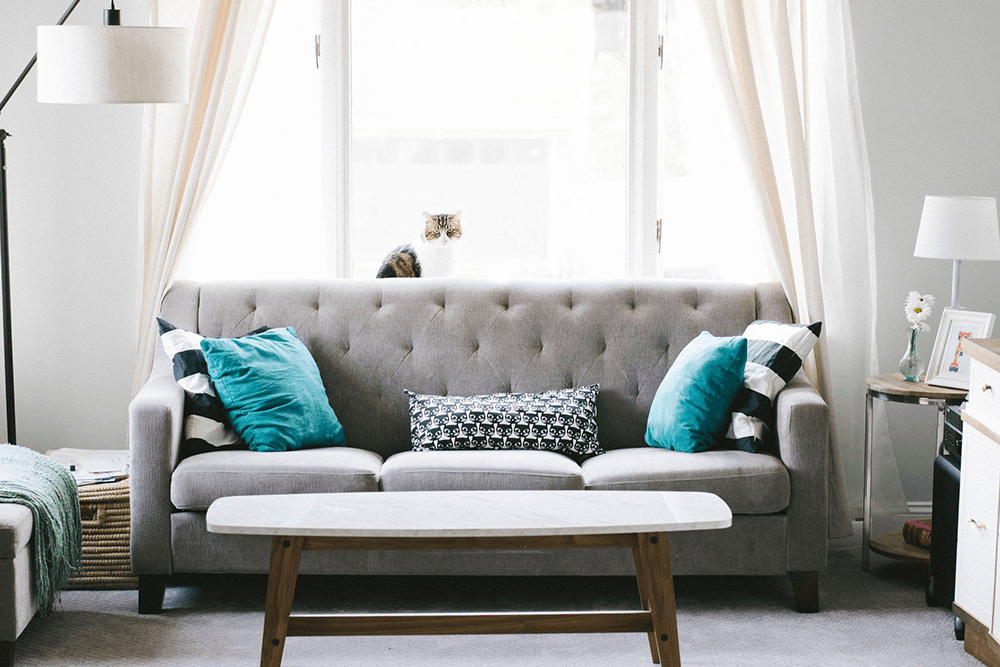
 Storage Tips
Storage TipsHow to Pack & Store Furniture in a Storage Unit
Whether you're downsizing, decluttering, or temporarily storing furniture between moves using the right packing materials and storage methods is going to keep your furniture in good condition.
Clean Your Furniture Thoroughly
Be sure to clean the furniture before storing it. Why? Cleaning helps to prevent damages caused by moisture, dust, or leftover food particles that can attract unwanted pests.
Avoid Plastic Wrap When Storing Furniture
Try to avoid using plastic wrapping on fabric or wood pieces, especially for long-term storage. Plastic tends to generate moisture that can lead to mold or stains on the fabric. Wood furniture is usually polished or oiled to help retain its appearance. If possible, always dismantle stacked segments, table extensions, and table legs.
Use Fabric Dust Covers to Protect Furniture
Consider using a fabric dust cover to prevent furniture from getting stained scratched or warped. Place a blanket wrap over the dust cover. It's added protection from the light and dust. It also provides a cushion to avoid damage from objects brushing up against each other.
Tuck the blanket warps into the nooks and crannies nice and tight, covering the entire surface. To make sure the blanket wrap doesn't come loose use packing tape on the outside to hold the sides and corners in place.
How to Protect Large Paintings for Storage
Large paintings or decorative framed mirrors need specialized boxing. Regular packing boxes won't protect these items. Expandable picture boxes are flat designs in different sizes and to accommodate large and fragile furniture items like pictures, glass mirrors, or television screens. They have formed corners to hold the items in place in the box. The ends slide together to close.
How to Protect Glass Tabletops for Storage
Glass tabletops also need some special handling. Wrap the top in packing paper first and without touching the glass secure the paper with tape. Next, choose the bubble wrap size to wrap around the paper. Secure it again with the tape and make sure there's no movement. Now you're ready to measure the box size for storage. Some people prefer to have custom wood crates built for added protection of glass items.
How to Protect a Mattress and Box Spring for Storage
Mattresses and box springs need to be cleaned before and after storage. Each piece needs its own separate cover while in storage. Here's the hard part; some people agree that mattresses and box springs were designed to lay flat and standing up for an extended period could damage its durability. Be sure you select the right unit size to accommodate your decision and the mattress size. Avoid stacking items on top of it, no matter how well wrapped.
How to Protect Patio Furniture for Storage
Patio furniture cushions share the same preparations as mattresses. Clean each one and store them in individual cushion covers until next season. Wood, metal, or plastic pieces should be treated with a light protective coating and covered in storage. A few extra minutes of care will give these pieces many more seasons of enjoyment.
Climate Control Self-Storage Units are Great for Storing Furniture
Climate control features may be one of the best upgrades to storage units. Why? Items stored in self-storage units usually need protection from the natural elements like changing temperatures. You can be assured that the inside temperatures of self-storage environments are consistent year-round. Some of your favorite and more expensive pieces of furniture require an added source of ventilation. Along with the climate control features designed to maintain ventilation, it's a good idea to place furniture above the floor by using a pallet system.
The decision to choose a non-climate control environment over a climate control unit due to cost could eventually lead to damage and higher replacement costs for wood and fabric furnishings. Paper documents and treasured family photographs are susceptible to damage with irregular temperature changes. Too dry and paper becomes brittle literally falling to pieces.
Label Your Boxes with Care
Labeling the boxes with notes to "handle with care -- fragile -- glass" helps to prevent breakage. Disassembled items should be placed in visibly marked boxes. It's going to help reduce any frustration when it comes time to reassemble.
Box Stacking Tips and Tricks
Never stack boxes on top of large furniture. Stacking makes the best use of limited space when done correctly. Careless packing and stacking can cause irreparable damage to precious items. Boxes should be sturdy enough to withstand collapsing. Old boxes can easily be knocked over, tumbling, and breaking the packed contents.
In some cases, lightweight boxes can sit on top of covered appliances for easy access. No cramming. Large items need to be stored towards the back of the unit and secured to prevent moving or falling forward. Medium-sized boxes should be stacked on the sides of the unit and smaller boxes towards the front or center. Safety precautions include creating accessible aisles within the unit and limiting the height of stacked boxes.
Keep the Hazardous Materials at Home
A word from the wise. Self-storage units are not designed to store hazardous or flammable items. Some cleaning materials are considered combustible, environmentally dangerous, or inappropriate for storage. Storing these types of compounds puts everyone's unit and contents at risk. The items should be appropriately disposed of during the packing stages, not stored.
How to Protect Wood Furniture for Storage
Protecting wood furniture for storage is essential to maintain its beauty and prevent damage. Clean it thoroughly, apply furniture wax, and disassemble if possible. Then, wrap each piece in furniture blankets or pads, securing them with plastic or bubble wrap. Use fitted furniture covers, elevate furniture off the ground, and opt for a climate-controlled storage unit for stable conditions. These steps ensure your wood furniture remains in great shape during storage.
What Size Storage Unit Do I Need For My Furniture?
Determining the right size storage unit for your furniture depends on the quantity and size of the items you plan to store. Here's a general guideline to help you choose the appropriate unit:
Small Furniture (e.g., nightstands, end tables, chairs, small bookshelves):
A 5x5 or 5x10 unit should suffice for storing small furniture pieces. These units are about the size of a walk-in closet and can accommodate several small items.
Average-Sized Furniture (e.g., sofas, dressers, dining tables, mattresses):
For an apartment or one-bedroom furniture, consider a 10x10 unit. This size is akin to a standard bedroom and can hold the essentials. For larger pieces like sofas, you might need a 10x15 unit.
Full House Furniture (e.g., furniture from a 2-3 bedroom house):
A 10x20 or 10x30 unit is suitable for storing the contents of a full house. These units offer ample space for furniture, appliances, and other household items.
Specialized or Oversized Furniture (e.g., pianos, large sectionals):
For oversized or specialized furniture, you may need to assess your storage requirements on a case-by-case basis. Measure the dimensions and consult with the storage facility to ensure you choose the right unit size.
Always consider the layout and how you plan to arrange your furniture within the storage unit. Leave a clear pathway to access items you might need later. Additionally, if you're storing delicate or valuable pieces, consider climate-controlled storage to protect them from temperature and humidity fluctuations. You should check with your chosen storage facility for guidance and to confirm unit availability.
How Do You Organize Furniture in a Storage Unit?
Efficiently organizing furniture in a storage unit involves disassembling when possible, such as modular furniture, using protective materials like blankets and plastic wrap to shield against damage, and elevating items off the floor using wooden boards or pallets. When stacking, prioritize placing the heaviest pieces at the bottom and lighter ones on top, and consider positioning smaller items within larger ones to maximize space. Create clear walkways within the storage unit for easy access, and label each item and its corresponding covering or box for quick identification. Additionally, for sensitive items like wood furniture, electronics, or antiques, consider renting a climate-controlled storage unit to maintain stable temperature and humidity levels, reducing the risk of damage from extreme conditions. These practices will help you make the most of your storage space while ensuring the safety of your furniture.
Moving to storage isn't difficult if you follow a few tips. Make sure you choose the right unit size. Layouts within the storage unit are as important as how these items are packed. What these two actions share is assurance for keeping stored furniture in good condition.
We're Your Storage Solution!
Storage Rentals of America is your convenient self-storage solution. So come into our office or give our storage experts a call at 1-800-457-5678. Our call center is available 7 days a week and can help determine which storage unit size best fits your storage needs.



